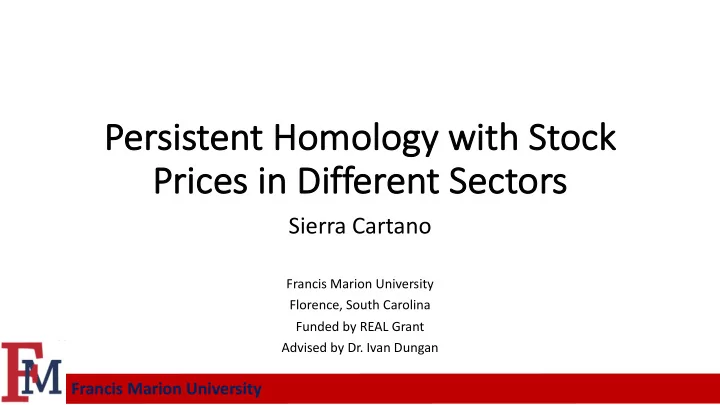

Pe Persistent Homology with Stock Pr Prices in Different Sectors Sierra Cartano Francis Marion University Florence, South Carolina Funded by REAL Grant Advised by Dr. Ivan Dungan Francis Marion University
Overview • Determine a way to identify the sector* of any random stock • Use topological data analysis, specifically, persistent homology. • Homology is the mathematics for identifying holes in a shape • Persistent homology identifies holes that persist over time. • Determine way to identify a random stock by sector with its unique homology • Apply to financial data *Financials, Utilities, Energy, Materials, Industrials, Consumer Discretion, Consumer Staples, Health Care, Information Technology, Telecommunication Services, Real Estate Francis Marion University
Example of a Point Cloud Francis Marion University
Different Dimensional Holes • 0-dimensional holes= connected components • 1-dimensional holes= circles • 2-dimensional holes= spheres Francis Marion University
Example of a Point Cloud Francis Marion University
Radius=1 Francis Marion University
Radius=2 Francis Marion University
Radius=3 Francis Marion University
Method of Persistent Homology • A(-6, -2) • B(-3.8, -2.2) • C(-6, 1) • D(-4, .5) Download data into • • E(4, 1) Excel spreadsheet • F(4.5, -1.5) Save as text file • Run through Ripser • • G(11, 1.5) • H(11.5, -.5) Francis Marion University
Persistence Diagram Persistence refers to topological features persist over a period of time. Connected Components Circles Francis Marion University
Radius=1, 2, 3 Radius=2 Radius=1 Radius=3 Francis Marion University
Persistence Diagram Persistence refers to topological features persist over a period of time. Connected Components Circles Francis Marion University
Circles Francis Marion University
BP Prudhoe Bay Royalty Trust Francis Marion University
BP Prudhoe Bay Royalty Trust (BPT) *Blue squares are spheres Francis Marion University
Phillips 66 (PSX) Francis Marion University
BPT vs. PSX Birth/Death Plots PSX BPT Persistence diagrams can be compared using the bottleneck distance. Francis Marion University
Method of Sector Classification • Companies from energy, financial and technology sectors • Data gathered from NASDAQ and Yahoo • 60 companies from each sector • 30 training data • 30 test data Francis Marion University
Ideal Situation Each point is a persistent diagram from each sector. Francis Marion University
Ideal Situation Distance between persistence diagrams calculated with bottleneck distance. Francis Marion University
Ideal Situation Francis Marion University
Output of Results The program to calculate the bottleneck distance was run 100 times. Francis Marion University
Output of Results Francis Marion University
Future Work • What is the correct statistic to describe the results? • What is the best way to adjust the sliding window function? • Is there a way to match up the parameters to produce a valid result? • Is there a way to include H0, H1 and H2 when running the data? Francis Marion University
References Joshua Dean, Spring 2014, Homology using linear algebra. Gunnar Carlsson, February 2005, Computing Persistent Homology Robert Ghrist, January 2008, Barcodes: The Persistent Topology of Data Jose A. Perea and John Harer, November 2013 , Sliding Windows and Persistence: An Application of Topological Methods to Signal Analysis Saba Emrani, Thanos Gentimis, and Hamid Krim, September 2014 , Persistent Homology of Delay Embeddings and its Application to Wheeze Detection Francis Marion University
Recommend
More recommend